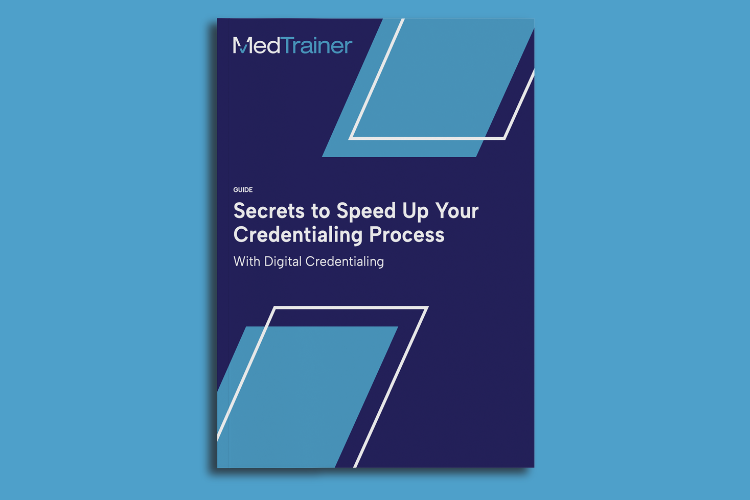Provider credentialing ensures healthcare organizations maintain a high standard of care by verifying the qualifications and competencies of their staff. The efficient management of healthcare professionals’ credentials is crucial; however, credentialing is traditionally a tedious manual process. To streamline it, many healthcare entities are turning to innovative solutions like provider credentialing software.
What Is Provider Credentialing Software?
Provider credentialing software is a digital solution to manual credentialing. It’s designed to simplify and automate the process of verifying and assessing the qualifications, education, training, and licenses of healthcare professionals. It replaces paper-based workflows with streamlined electronic procedures, allowing healthcare organizations to manage, track, and maintain up-to-date credentialing information for their staff.

Get secrets to speed up your credentialing process.
Key Benefits of Provider Credentialing Software
By centralizing and automating workflows, provider credentialing software helps healthcare organizations maintain accurate provider information, reduce administrative burdens, enhance patient safety, and facilitate smoother collaborations among medical staff.
Switching to provider credentialing software comes with numerous benefits, including:
- Efficiency and accuracy. Provider credentialing software eliminates the need for manual data entry and paperwork. This reduces the risk of errors and ensures accuracy in credentialing records.
- Time savings. Automating the credentialing process significantly reduces the time required to gather, verify, and update provider information. This enables organizations to expedite onboarding and maintain compliance with minimal administrative burden.
- Compliance and regulatory adherence. Provider credentialing software often includes built-in checks to ensure compliance with regulatory requirements, such as state licensure and certifications. This reduces the risk of non-compliance and associated penalties.
- Real-time updates. With provider credentialing software, organizations can access real-time updates on provider credentials. This is particularly important for tracking expiring licenses, certifications, and other time-sensitive credentials.
- Centralized documentation. All provider credentialing documentation — such as licenses, certifications, and training records — can be stored in a centralized digital repository. This ensures easy access and simplifies the auditing process.
- Enhanced security. Digital credentialing platforms offer enhanced security features, to protect sensitive provider information from unauthorized access.
- Credentialing Verification Organization (CVO) integration. Many provider credentialing software solutions like MedTrainer can integrate with CVOs, allowing for a seamless exchange of credentialing information with external verification sources.
- Provider profiles. Provider credentialing software often includes the capability to create comprehensive profiles that capture all relevant information, making it easy to assess qualifications and track ongoing compliance.
- Streamlined communication. Software includes communication tools that enable direct communication between providers and the credentialing team, streamlining the verification process.
- Enhanced provider relationships. Providers who have a streamlined, faster credentialing process are more likely to stay with the organization.
Key Features of Provider Credentialing Software
Provider credentialing software should offer a range of features to simplify the overall credentialing process. Here some of the key features that make provider credentialing software an indispensable tool:
Provider profile management
Provider credentialing software offers a comprehensive provider profile management system that consolidates all essential information, documents, and communication in a single, easily accessible location. This centralized profile allows credentialing teams to efficiently monitor the status of enrollments, track verification progress, and access necessary documents. This feature not only saves time; it also reduces the likelihood of errors by eliminating the need for duplicate data entry.
Additionally, software solutions can integrate with the Council for Affordable Quality Healthcare (CAQH) provider management, simplifying the data entry process and ensuring accurate and up-to-date information.
Automated notifications and reminders
Automated notifications and reminders are a cornerstone of effective provider credentialing software. These features ensure that relevant parties are alerted to upcoming deadlines 90 to 180 days ahead of time, pending verifications and any outstanding actions required. By automating these notifications, healthcare organizations can reduce the risk of missed deadlines, maintain compliance, and keep the credentialing process on track.
Highly-customized reporting and dashboards
Provider credentialing software offers highly customizable reporting and dashboards that empower healthcare organizations to access the data they need to make informed decisions. These reports and dashboards provide visibility into gaps, upcoming action dates, locations, and more. Users can save their favorite reports for easy access and even schedule reports to be sent via email on a daily, weekly, or monthly basis.
Automated exclusions monitoring
Automated exclusions monitoring is a crucial component of provider credentialing software. This feature involves automated checks against exclusion databases such as the Office of Inspector General (OIG) and System for Award Management (SAM). Any status changes or matches are promptly flagged, transforming hours of manual work into a matter of seconds. It minimizes risks and ensures compliance with regulations. Look for software that offers customizable sorting options, such as by status, regulatory agency, exclusion check date, and more.
Customizable workflows
Provider credentialing software often offers customizable workflows that align with the unique needs of each healthcare organization. These workflows guide users through each step of the credentialing process, ensuring that nothing is overlooked. Customizable workflows enhance efficiency by tailoring the software to match existing processes and preferences.
Enrollment management
This feature helps organizations manage the enrollment process with insurance payers, ensuring a smooth revenue cycle. A unified view of application status, priority, last update, and more keeps enrollments progressing seamlessly. Look for software that includes enrollment report templates, simplifying the monthly reporting process and providing insights into enrollment progress.
Speed Up Provider Credentialing With MedTrainer
Quality provider credentialing software can dramatically improve your organization’s processes. MedTrainer organizes and accelerates your process with cloud software and a team of specialists who can manage the process for you. Customers say that on average, MedTrainer speeds up credentialing by three weeks — per provider! This means faster speed-to-care and less risk on the part of the organizations employing them.
With MedTrainer Credentialing, all the data you need to make business decisions is in one place. From provider data and files to upcoming action dates and automatic reminders, MedTrainer provides a single place to enter, import and store mandatory provider information and documents based on NCQA guidelines. Explore MedTrainer’s credentialing features today!
